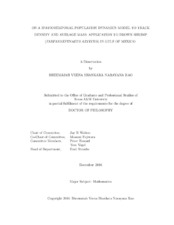| dc.description.abstract | Structured population models have been used to model density of individuals over time and other factors such as age, mass, developmental stage and space. Mass is a particularly useful measure of condition of a population. For example, large individuals tend to reproduce more offspring and survive better than smaller ones. Traditional models of mass as a continuous structure parameter do not introduce a separate partial differential equation (PDE) for mass; rather they model the population as being subdivided into classes parameterized by mass and then number density is written as a function of spatial location, time and mass. Our approach to modeling mass dependent population dynamics introduces mass as a dependent variable. In particular, we developed a new PDE for mass where mass is a function of spatial location and time.
We constructed a spatiotemporal population dynamics model to track density and average mass of the population at location x and time t and the model will be called as density and mass model. Our model provides an insight into the identification of key processes (reproduction, growth, mortality) controlling populations over various space and time. We developed a finite difference scheme for the numerical solution to the system of PDEs arising from our modeling effort. Then the model is applied to brown shrimp in the Gulf of Mexico to understand their spatiotemporal dynamics of density and mass.
To derive a density and mass model, we start with conservation laws for biomass and number density. Then, we define average mass and derive the system of coupled parabolic and hyperbolic PDEs for spatial movement of individuals in a population. Then, birth, growth and death processes are added to derive the final system of PDEs to include spatial movements, birth, growth and death of individuals. Then, we impose fishing to some locations to investigate fishery yield.
Among the issues studied in the application of the general theory to brown shrimp in the Gulf of Mexico are: (1) investigate how the mobility of species affects the yield with multiple fishing zones and network of marine protected areas (MPAs), (2) test the efficacy of MPAs under multiple fishing zones, and (3) investigate how mass dependent mortality influences density and mass of a population. Calculating yield is critically important for helping the fishers to earn a better profit and keeping the population sustainable.
The results show that (1) to obtain a maximum sustainable biomass yield (MSBY), it is crucial to consider the speed or mobility of species under consideration before MPAs are designed, (2) when a network of MPAs are designed along the coastline, the fishing rate at MSBY increases with the number of marine protected areas and (3) small MPAs are very effective in producing a sustainable biomass yield for a low mobile species. | en |


